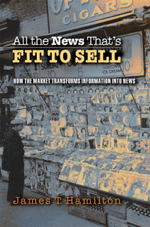 [For Chapters 7 and 8 of this month’s Nieman Journalism Lab Book Club selection, we turn to Tim Windsor. For more info on the Book Club, check here. —Ed.]
[For Chapters 7 and 8 of this month’s Nieman Journalism Lab Book Club selection, we turn to Tim Windsor. For more info on the Book Club, check here. —Ed.]
While the previous chapter’s data about the early days of online news do not age well, the focus of Chapter 8 — the value of celebrity among television anchors in 1999 and the likelihood that a political pundit will speak in shorthand and soundbites on television — hold up better.
In short, Chapter 8 is all about how television news personalities — whether anchors or pundits — became high-priced and marketable commodities, and how at least some of them streamlined their act (dumbed it down, Hamilton implies) for the small screen.
Among the evidence cited:
1. Television news anchors in the late 1990s made much more money than their predecessors. By any measure, these anchors commanded significantly higher salaries, even though ratings for the network evening newscasts had already begun their inexorable slide ten years ago, the date of the data set. The reason? Their networks believed that the celebrity and the personality of the anchor served to pull in viewers, especially as the marketplace became more competitive with the growth of cable.
In 1976 anchors such as Walter Cronkite and John Chancellor were paid the equivalent of 28 ads per year, while in 1999 this had grown to 149 ads for Dan Rather and Tom Brokaw… This was a time of declining absolute audiences, but rising importance of anchors in attracting viewers.
2. This popularity translated beyond the tube. In a study of available prices at a speaker’s bureau in the late 1990s:
The star quality associated with well-known television reporters and some print journalists translates into a demand for speeches. [T]he mean speaking fee for reporters is higher than for the former politicians that they once covered.
3. Political pundits were more likely to offer nuanced arguments in print and tended to simplify their message, use smaller words and “play to type” when appearing on television.
Given the same subset of possible events and ideas to talk about, those appearing on television were more likely to focus on human interest elements, use simplified language, and make self-references than those writing in print outlets. Journalists who appear in two media adopt the conventions of the particular outlet type when discussing events. … The combination of audience demands served by television and the technology of information delivery creates incentives for individual journalists to approach politics differently in print than in broadcast.
As a case study, Hamilton cites George Will. Analyzing his columns and his appearances on ABC news in the late 1990s, Hamilton notes:
In terms of the summary measures calculated by (the study), George Will’s changes between print and television embody the different market imperatives of the two media. On television Will offers opinions that are marked by greater activity, realism, and certainty. In print, he is more likely to use abstract terms relating to groups and their actions. Though George Will has developed a brand name for expression, he changes the delivery of his product to suit the audience demands and cost constraints of the medium.
Chapter 8 doesn’t exactly break new ground, but it is interesting in that it puts some original research behind commonly-held assumptions about television news personalities. As to whether it holds today for Katie Couric, Rachel Maddow, Sean Hannity, Brian Williams and others in the current crop of TV news stars, there’s no evidence here either way but, based on their continuing heavy promotion, on cable and broadcast, it seems that the network bosses continue to believe that personalities still drive loyalty and viewership.